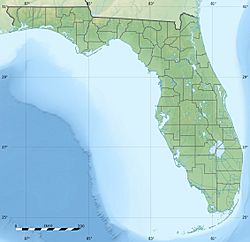St. Vincent Island (Florida) facts for kids
| Geography | |
|---|---|
| Coordinates | 29°39′40″N 85°08′37″W / 29.66111°N 85.14361°W |
| Administration | |
| State | Florida |
| County | Franklin |
St. Vincent Island is a special barrier island off the coast of Florida. It is the westernmost of four islands in the northwestern Florida Gulf coast. These islands include Cape St. George Island, St. George Island, and Dog Island. St. Vincent Island is located near the mouth of the Apalachicola River. It is also close to the town of Apalachicola on the Florida Panhandle.
Contents
Island History
Ancient Times
People have lived near St. Vincent Island for a very long time. Archeologists found old stone tools on the island. These tools are called Paleo-Indian projectile points. They are about 13,000 years old. Back then, the sea level was much lower. This means the area was not an island but part of the mainland. Pottery pieces from 4,000 years ago were also found. These were on the north shore of the island. They might have been left there as the island was forming.
Early European Contact
In 1633, Franciscan Friars visited the Apalachee tribes nearby. They were the ones who gave the island its name. Later, around 1750, Creek Indians and Seminoles moved into the area. They lived on the island for some time.
The War of 1812
During the War of 1812, the British used St. Vincent Island. They unloaded military supplies there. This was part of their plan to invade the United States. They wanted to attack through the Flint River (Georgia).
Island Owners and Animals
In 1868, a man named George Hatch bought the island. Later, in 1908, Dr. Ray V. Pierce brought new animals to the island. These were game animals from other parts of the world. In the 1920s, the island was used to raise beef cattle. These cattle were sold in Apalachicola.
In 1948, the Loomis brothers bought St. Vincent Island. They brought in many different animals. These included zebras, elands, black buck, and various birds. Some of these birds were ring-necked pheasants and bobwhite quail. They also had semi-wild turkeys.
Becoming a Wildlife Refuge
In 1968, a group called Nature Conservancy bought the island. They paid $2.2 million for it. The U.S. Fish and Wildlife Service then bought it from them. They used money from Duck Stamp sales. This is how St. Vincent Island became the St. Vincent National Wildlife Refuge. It is now a protected area for animals.
Island Geography
St. Vincent Island has a unique landscape. It is made of sand ridges and low, wet areas called swales. These areas are covered with trees like live oak and other hardwoods. The oldest sand ridge on the island is about 3,000 years old. The island also has tidal marshes. These are wetlands affected by ocean tides. There are also 18 square miles (49 km2) of freshwater lakes and streams.
Island Wildlife
St. Vincent Island is a home for many different animals. You can find lots of shore birds there. There are also many alligators. Large birds like ospreys and bald eagles build their nests on the island. You might also see peregrine falcons and wood storks.
The island is also home to sambar deer, which are from Southeast Asia. Native white-tailed deer also live there. St. Vincent Island is a safe place for endangered species. These include loggerhead sea turtles, indigo snakes, and gopher tortoises. The rare red wolf also finds a haven here.
Things to Do
St. Vincent Island is only reachable by boat. But once you arrive, there are many fun things to do!
Water Activities
The island is a great spot for sea kayaking and boating. You can also enjoy fishing along the shore. It is a popular place for birding, which means watching birds.
Exploring the Island
The inside of the island has over 90 miles of roads. These roads are open for hiking and biking. Not all roads are still used often. The main road, called B Road, is covered with oyster shells. This makes it easier to travel over the sandy ground.
Fishing and Wildlife Viewing
You can also watch wildlife as you explore. Fishing is popular in the island's four lakes. These lakes are stocked with fish like largemouth bass and bluegill.
Special Hunts
Sometimes, there are special hunts on the island. These primitive hunts help control the animal populations. They manage the numbers of Sambar deer, White-tailed deer, feral hogs, and raccoons. Licenses for these hunts are given out by a lottery. The Florida Fish and Wildlife Commission manages these hunts.


